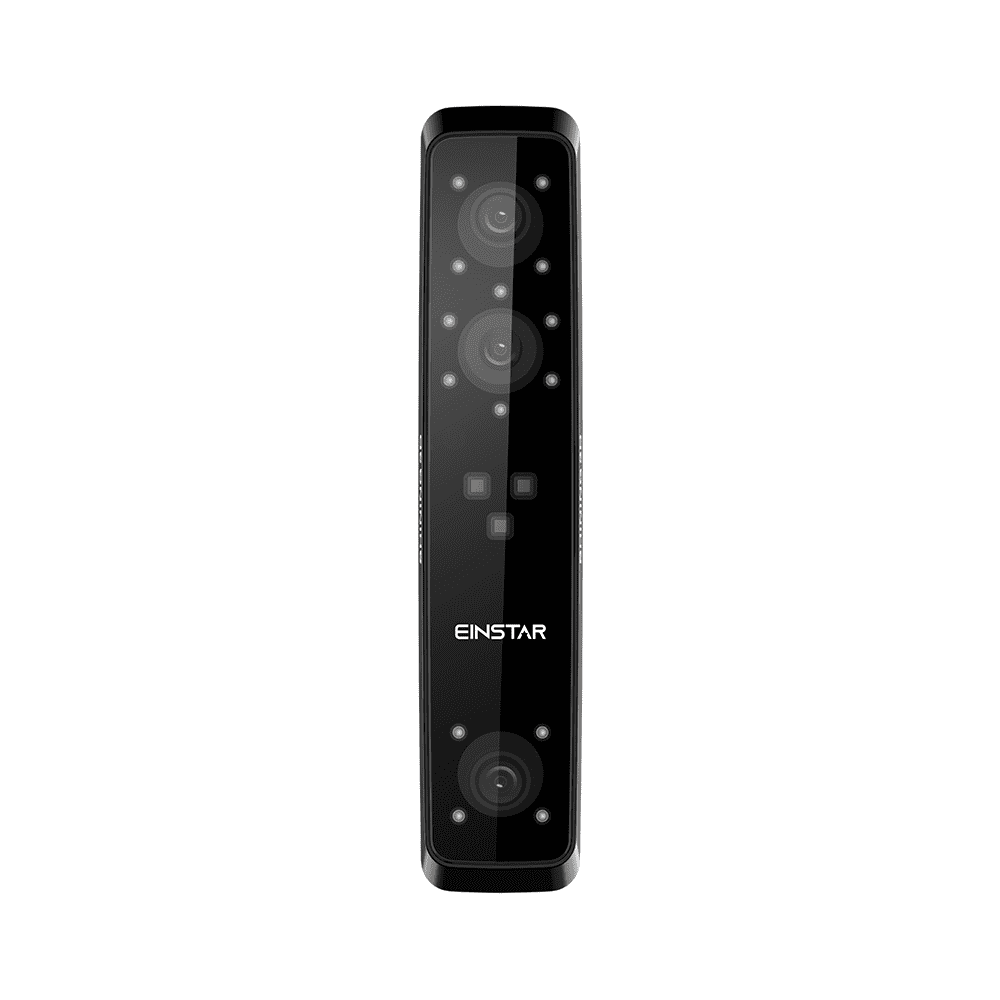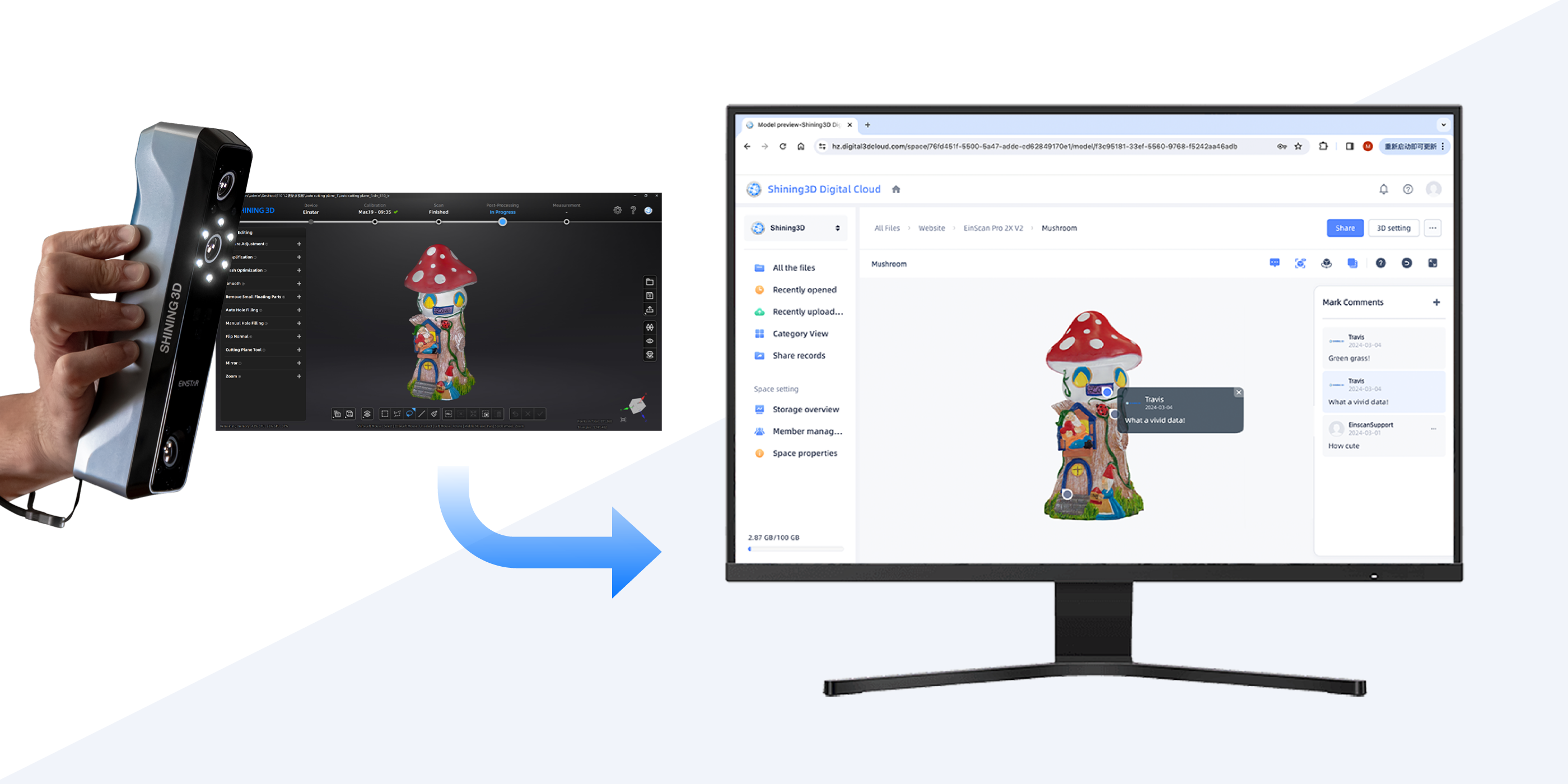- Descripción general
- Descripción
- Presupuesto
- Galería de datos 3D
- Cómo utilizar
- ¿Qué hay en la caja?
- Preguntas frecuentes
- Reseñas














EINSTAR Escáner 3D portátil de consumo
Tax excluded. Shipping policy.

Restauración de escaneo real
Los nuevos algoritmos de software Einstar v1.2 obtienen detalles de datos más nítidos y claros y texturas vívidas con mayor facilidad.



Datos de alta calidad
Recopile datos de nubes de puntos de alta densidad de forma rápida y sencilla con una distancia de puntos de hasta 0,1 mm.

Alta fidelidad de color
Benefíciese de la cámara de color RGB incorporada. Datos 3D con colores auténticos.

Ideal para superficies oscuras o brillantes.
El VCSEL infrarrojo es ideal para escanear superficies reflectantes negras y brillantes, lo que garantiza una captura confiable de objetos desafiantes.

Software fácil de usar
- El indicador de calidad de datos optimiza la nube de puntos para una adquisición de datos completa.
- Múltiples formatos de salida (OBJ, STL, PLY, P3, 3MF) admiten diferentes software de diseño CAD e impresoras 3D.
- La nueva función de rebobinado de datos evita que se pierdan todos los datos si ocurre algún error o desalineación durante el escaneo.

Nube digital 3D BRILLANTE
Comparta datos de escaneo 3D con un solo clic en la plataforma de nube digital SHINING 3D. Muestre su gran creatividad.

Experiencia de usuario optimizada
Suave y rápido, velocidad de escaneo de hasta 14 FPS.
- Fácil instalación y operación.
- Alineación automática.
- Algoritmo inteligente.
- Rendimiento de seguimiento inteligente.

Cómodo para los ojos, fácil de escanear el cabello
- No hay luz del proyector durante el proceso de escaneo.
- Cómodo y seguro para los ojos.
- Activar el "Modo Cabello" para obtener suficientes datos del cabello para el escaneo humano y mejorar la integridad de todos los datos.

Escaneo estable en exteriores
- Equipado con 3 proyectores infrarrojos VCSEL, 2 cámaras de profundidad estéreo y 1 cámara RGB, Einstar puede capturar datos de escaneo claros y generar salidas estables en exteriores.
Especificaciones del producto
Escaneo de luz estructurada
0,1 mm ~ 3 mm
Luz estructurada VCSEL infrarroja
Distancia de trabajo efectiva: 160 mm-1400 mm Distancia de trabajo óptima: 400 mm
160-1400 mm
434 mm x 379 mm (distancia de trabajo óptima)
980.000 puntos/s, hasta 14 FPS
Alineación de características, alineación híbrida, alineación de texturas, marcadores globales
Seguro para los ojos
Sí
USB2.0 o superior
Sí
OBJ; STL; CAPA; P3; 3MF
220 mm x 46 mm x 55 mm
500 gramos
245 mm x 245 mm x 90 mm
0-40 ℃
10-90%
Sistema operativo: Win10/11, 64 bits;
Tarjeta gráfica: NVIDIA GTX1050;
Memoria de vídeo: ≥6 GB;
Procesador: I7-11800H;
Memoria: ≥32 GB
Sistema operativo: MAC;
Apple Silicon: M1 Pro o superior (GPU de 8 núcleos o más);
RAM: 32 GB o más;
USB: 2.0;
Sistema operativo: macOS Ventura 13 o más reciente
Sistema operativo: Win10, 64 bits;
Tarjeta gráfica: NVIDIA GTX1050;
Memoria de vídeo: ≥4 GB;
Procesador: I7-7700H;
Memoria: ≥16 GB
Sistema operativo: MAC;
Apple Silicon: M1 o superior (GPU de 8 núcleos o más);
RAM: 16 GB o más;
USB: 2.0;
Sistema operativo: macOS Ventura 13 o más reciente
CE, FCC, ROHS, RAEE, KC
* La fuente de luz infrarroja EINSTAR, certificada como producto láser de clase 1, es segura en todas las condiciones de uso normal.
* La alineación de marcadores globales solo está disponible en el modo de escaneo de objetos.
* EINSTAR requiere una computadora equipada con tarjeta gráfica NIVIDA.
Galería de datos 3D
Preguntas frecuentes
Explore respuestas a preguntas comunes sobre nuestros servicios, productos y políticas.
¿Por qué elegir el escáner 3D Einstar?
Einstar ofrece un campo de visión amplio con alta luminosidad que facilita enormemente algunos trabajos complejos de escaneo de colores oscuros, cabello y exteriores. El software con seguimiento inteligente, alineación automática y edición de datos sencilla ayuda a controlar la calidad de los datos. El escáner y el software son fáciles de usar y muy amigables para los usuarios, incluso si es la primera vez que escanean en 3D.
¿Cuál es el tamaño de objeto más grande/más pequeño que puede escanear?
El tamaño más pequeño sugerido es 100*100*100 mm. El tamaño más grande depende de la RAM; una RAM más grande puede admitir objetos más grandes.
¿Cuáles son los requisitos de configuración de la computadora?
- CPU: Intel Core i7-11800H o superior
- RAM: 32 GB o más
- Tarjeta gráfica: NVIDIA GTX 1060 o superior
- VRAM: 6 GB o más
- Sistema operativo: Windows 10/11 de 64 bits
¿Cuánto tiempo tardaré en llegar mis pedidos?
Depende de dónde te encuentres. Los pedidos procesados aquí tardarán entre 5 y 7 días hábiles en llegar. Los envíos al exterior pueden tardar entre 7 y 16 días. Los detalles de la entrega se proporcionarán en el correo electrónico de confirmación.



























